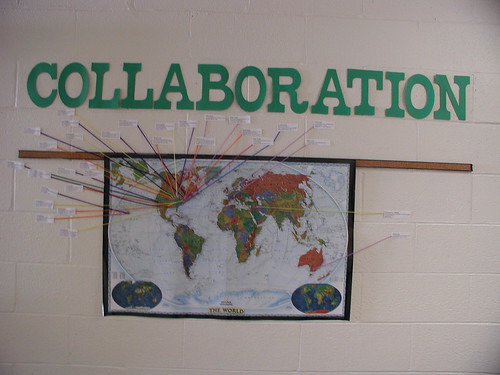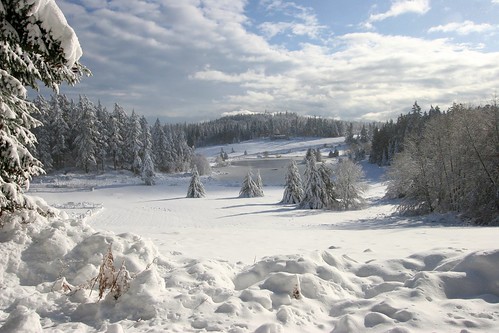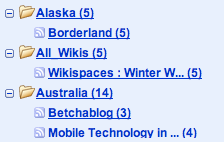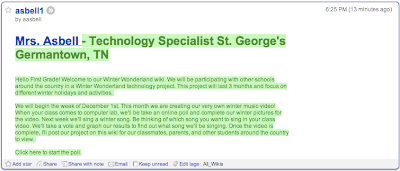 A couple of weeks ago, I went to Kean University’s Going Global conference. One of the new things I learned was an interesting method to use an Activboard. I stopped by for a session offered by the Promethean company. I picked up a tip from one of the presenter’s named Rob. While it is specifically useful for the Activstudio software, the idea could be adapted using Word and the highlighter option.I learned how to use the Activstudio software by taking their online tutorial. This tutorial was very good as far as learning how to operate the software. The piece I am missing is seeing how outstanding teachers use the board and software with their students.
A couple of weeks ago, I went to Kean University’s Going Global conference. One of the new things I learned was an interesting method to use an Activboard. I stopped by for a session offered by the Promethean company. I picked up a tip from one of the presenter’s named Rob. While it is specifically useful for the Activstudio software, the idea could be adapted using Word and the highlighter option.I learned how to use the Activstudio software by taking their online tutorial. This tutorial was very good as far as learning how to operate the software. The piece I am missing is seeing how outstanding teachers use the board and software with their students.
Activstudio, Text, and the Paint Bucket
I learned that when I am using Activstudio, I could prepare a block of text on a page. Once the text is on the page, the paint bucket will color a full word when it is clicked. Rob gave me an example of having students find all the nouns (or other parts of grammar) within the text block.
Activstudio and Monster Project Preparation
I decided to give this method a try with my second grade students. I wanted to introduce the Monster Project that I will be working on with Anna Baralt and other teachers. Since this is the second time I will be drawing monsters collaboratively, I have work online to show the students.I began the project by reading the book Many Luscious Lollipops to the students to get them focused on adjectives. After reading the book, I brought my wiki up on the projector with last year’s projects. Last year, I completed the project with second and third grade students. Many of my current second grade students have brothers, sisters, or friends the grade ahead. They enjoyed looking at the original drawings and the redrawn images. Next I found a description written by one of the student’s sisters.
1. My monster has a round, blue body that's outlined in gray.2. It has six eyes. There are two black, two pink, orange, and blue with pink glasses.3. It has a pig-snout nose, a small yellow smile, and orange wings on its bottom.4. It has a black crown.
5. It is plump and short.
6. There are crazy ears (and stubby hair) coming out of its blue ears.7. It has no arms, but stubby blue, short legs.8. It lives in a pink area.
9. There is an angry sun with yellow eyes and mouth.
We sat in a circle around the Activboard. Each student took turns looking for adjectives and using the paint bucket to choose a color and click on the word. Each student had at least three turns since the description had so many adjectives. I stayed at the computer behind the projector. As each word was clicked, I asked the students if they thought it was or was not an adjective and why. If the word was not an adjective, I clicked Edit – Undo to reset the word to black. This is the end result.
 One of the second graders told me that this is a great way to learn grammar and that their teacher should learn to use the board, too.
One of the second graders told me that this is a great way to learn grammar and that their teacher should learn to use the board, too.
Extensions to the Lesson
So far, we have followed the first lesson with a second lesson using Kidspiration. We are currently using version 2. The Science category has an Explore with Senses template. The students learned to use Kidspiration for the first time. I taught them the basics of selecting a category – Food and Health. They learned to use the blue arrows to move between the Foods, Fruits and Veggies, and Treats categories.
Once they dragged their favorite food to the center of the chart, they attempted to type five descriptive words for each of the five senses.
When we return from vacation, we will look at the student's work and try to find out which words are adjectives that can be used to describe the student's favorite food. I hadn't completed these preparatory activities first last year, we dove right into drawing monsters and writing descriptions. I know they will be prepared for better descriptive sentences this year.
I hadn't completed these preparatory activities first last year, we dove right into drawing monsters and writing descriptions. I know they will be prepared for better descriptive sentences this year.
 Most of my classes are connecting with at least one class somewhere in our country or around the world. I wanted a way to show all those connections in one place.
Most of my classes are connecting with at least one class somewhere in our country or around the world. I wanted a way to show all those connections in one place.
The Map Outside My Room
I've been doing a lot of cleaning and tossing of things at home. We are working on selling our house. At the beginning of September I found a National Geographic world map. I had the principal laminate it and I hung it outside the computer lab.
It was a pretty lonely map for most of September and October. I had joined a project with Lisa Parisi called Time Zone Experiences. We had a dot on Long Island, New York and another in West London, England. Next, I joined a Winter Wonderland project. My Kindergarten, first, and third graders created some movies with winter images created in Kid Pix. We have been viewing projects from other classes and leaving comments on the discussion tab on the wiki.
New Opportunities
This past week, I needed a couple of quick projects for my fourth and seventh graders. Over on the Elementary Tech Teacher's ning, I saw a message from Vicky saying that her fourth grade students created some Christmas tongue twisters in Voicethread. This was a great opportunity to show the fourth grade what a Voicethread was and how they could contribute. It really didn't take too long to explain how to choose their identity from a list I had preset in my ed.voicethread account. I set up a ten dollar education account last year so that I might have an easier time showing the site at public schools. Now I understand that this may be the only way to sign multiple students on through the same account at the same time.
As a follow up activity, I'm going to have the fourth grade create an image for their avatar in Kid Pix.
Old Opportunities
I used Voicethead with the current seventh grade when they were in my sixth grade math class last year. They already had avatars and identities. This year, I just had to remind them how to make a comment. They added to Silvia Tolisano's What Could It Mean Voicethread. It was a great activity for Christmas week. They left their ideas on what the images could mean if they lived in a different country or a different part of our country. When we return from vacation, I will assign each image to a group of students. They will have to decide which answer of all the responses could best describe the image. Finally, we'll review the actual answer.
Math Connections
Finally, our sixth grade students will be joining Linda Nitsche's students on a math collaboration. I found it via Lucy Gray's Global Education Collaborative ning's project database. Having taught middle school math for four years, I know there is never enough time to do all you would like with getting students to talk about math. This project will give us four opportunities over the course of the year to work on a data analysis, geometry, number operation, and measurement challenges.
Monster Project
This leaves two grades waiting for collaborations. My eighth grade students do not have a project in the works as of this time. My second grade students will be participating in a monster exchange. It is on the monsterproject.wikispaces.com site that Anna Baralt and I worked on last year. I am really looking forward to the project this year as I do more work in advance on adjectives in the second grade. If you'd like to join us this year, please let me know. We'd be happy to include your second or third grade class.

Image Citation:Ann Oro 23 December 2008.
 Every time I work on a collaborative project I learn more. Through the magic of the Elementary Tech Teacher's ning I found out about the Winter Wonderland wiki project. Each time I work on a project, I learn new ways to challenge myself and my students.
Every time I work on a collaborative project I learn more. Through the magic of the Elementary Tech Teacher's ning I found out about the Winter Wonderland wiki project. Each time I work on a project, I learn new ways to challenge myself and my students.
Many of the projects I work on still leave me wishing for more contact and understanding between my students and those of other classes. The three teachers leading this collaboration have certainly tried to bring more contact between the students. This project is for Kindergarten through grade three.
For Students - High Points in My Mind
There were two Google Form questionnaires for the project. One focused on the student's favorite winter holiday. The other focused on travel plans in December. I had my third grade students answer the questions on their own. I called the first grade students to my computer one at a time to answer the questions. I want to take the student data and make some comparison charts between the participating classes and my students.
For Teachers - High Points in My Mind
There are a large number of teachers signed up for the project. This is fantastic because even if many drop from the project, there are still going to be several participating classes. Early on in the project, teachers started using the discussion tab to ask each other questions and receive answers.
For Students - Areas to Improve
In all these types of projects, the teachers have huge buy in due to the amount of work they do. The students (in my case) drew one picture and sang a song. I had to make sure all the images were gathered, the song was recorded, the movie was created to merge the images and song. Once the movie was created and exported into Quicktime, I loaded it up on Vimeo. Finally, I embedded the movie on our wiki. I repeated the steps for two kindergarten, two first, and two third grade groups. I've been watching the number of class participants grow. I have the RSS connection to page edits and discussions in my reader and see the conversations taking place.
Here's the key area I need to improve: the students do not get the same build-up and involvement. I only see them once per week for forty-two minutes. I know, as I sit here reflecting, that I have to take more time to explain the projects I become involved in with the student's classroom teacher. I need to somehow allow the excitement to build within their classes. It's going to be hard because most of the computers are still running OS 9 in the building. For PC readers, it means there is a lack of ability to view some types of data on the Internet. If I can manage to upgrade at least one machine per classroom to OS X next year, I can ask the teachers to give the students access to checking on their partners over the course of the week.
By the time the students get to my class, they should be more excited to work on their own projects.
Built-in Excitement
We live in New Jersey. Some parts of our country just sound more exciting to my students. In the first and third grades, the students couldn't wait to see what was created in Hawaii and Alaska. It was really fun because they recorded their songs in their native tongue.
I tried to show the variety of projects to the students. My first graders were amazed by a project made by students in Alabama. Mrs. Coggin used a Smilebox template with Santa holding a laptop. The laptop reveals the student project.
The class in Hawaii really kicked it up a notch. They had a song about Alfie the Elf. Their teacher assigned a sentence from to song to each students. It made for a really fun viewable project that told a story.
Since we do not live in a high interest state like Hawaii, I have to make my projects that more interesting and attractive to the student audience.
For Next Time
I have to do what I know in my heart. When I create a project for students/ with students, it is not enough to just get it technically correct. It needs to tell a story. Big surprise? Not really, but I'm refocusing myself. I read the book Made to Stick over the summer. I have to read it again and apply those principals to the projects we create for other classes.
Was It a Waste of Time
I am confident that this is not a waste of time.
They are creating images for a bigger purpose than the forty-two minutes of one class period.
They are beginning to see that other people are responding to their creations.
They are getting the idea that they can see someone else's work and leave a message as a class.
They are learning that other people will answer their questions.
They are taking first steps to bigger, more personal connections with other students.
I look back at the first wiki I created in March 2007. It is a baby step along the way to some very rich material we have on the wiki today. I look forward to my students work on our wiki in March 2011. Each lesson I learn along the way marks the path to a more personal and involved experience in the future.
 Since writing this post, I added a follow up here.
Since writing this post, I added a follow up here.
First...Some Resources
I put out a message on Twitter stating my intention to use Google Forms to create a tablet cart reservation system. I wanted to know if anyone had any tutorials or pointers for getting started. I received two messages. Martha Thornburgh pointed me to a Web 2.0 Wednesday Challenge created in Google Sites. I really liked her Google Doc presentation called Creating Forms and Surveys Challenge Tutorial. It helped me understand how the forms and spreadsheets connect. It helped me understand how to make the form public, too.
Christy Tvarok Green pointed me to a YouTube video called Quick and Easy Forms with Google Docs. I watched a bit of it after looking at Martha's presentation, but by that time I felt confident moving forward.
Happy Final ResultsI put together a Saint Michael Tablet Cart Reservation form. It contains everything I think I might want to capture in reserving the cart: teacher name, date of reservation, help needed, and a place to type an 'x' to reserve the cart all day, and places to type an 'x' to reserve the cart by periods in the day.
In order to be able to check cart availability, I published the associated Google Spreadsheet as a public document.
Getting Around URL ProblemsThe biggest potential problem was publishing the URLs. I didn't want to type up a paper document or email the huge URL generated by Google. I decided to create a personalized TinyURL.
There is the ability to create a custom alias for a tiny URL. Now I have two:
http://www.tinyurl.com/sms-see-cart [and]
http://www.tinyurl.com/sms-get-cart
SMS stands for the school: Saint Michael School. I'm hoping the tiny URL is intuitive and relatively easy to remember.
Making It Easier on Me
 As I was looking at the URL for the spreadsheet, the tiny orange chicklet caught my eye. I wondered what would happen if I copied the RSS feed into Google Docs. Lo and behold! Whenever someone reserves the cart, I get instant - up to five minute delay - notice of the reservation and whether or not the teacher feels that they will need assistance in their room. You can see a sample at the top of this post.
As I was looking at the URL for the spreadsheet, the tiny orange chicklet caught my eye. I wondered what would happen if I copied the RSS feed into Google Docs. Lo and behold! Whenever someone reserves the cart, I get instant - up to five minute delay - notice of the reservation and whether or not the teacher feels that they will need assistance in their room. You can see a sample at the top of this post.
Downfalls
The biggest downfall was in the initial creation of the form. I didn't really think it through. I created it on-the-fly and made a different tiny URL. When I went to update the form, it did all kinds of crazy things to my spreadsheet. I ended up starting all over when I realized I didn't like the look of the spreadsheet and was too much of a novice to correct it.
I did learn, too, that I had to make the spreadsheet public so that the teachers could delete a row if they needed to reschedule the cart. Just to clarify things, most teachers do not use spreadsheets in the building. The first reservation needed to be reschedule and I walked the teacher through deleting the row with very little fuss.
Upside
All in all, if you're timid about getting started with Google Forms you should give it a try. There is an awful lot to be gained. The biggest upside, two teachers have used a Google Form and viewed a Google Spreadsheet this week. No training required.
 The best part about collaboration on a wiki is that no one person has to be centrally responsible to update pages or comments. The difficulty arises when there are numerous collaborators. I've been trying to establish some best practices for myself when it comes to project management for all my students.
The best part about collaboration on a wiki is that no one person has to be centrally responsible to update pages or comments. The difficulty arises when there are numerous collaborators. I've been trying to establish some best practices for myself when it comes to project management for all my students.
Winter Wonderland ProjectI currently have three grade levels starting a three month project. It was put together by Amber Coggin, Nedra Isenberg, and Vicky Sedwick. I am really struck by the level of organization in this project. I am very hopeful that with so many participants, my students will give and receive feedback between several different classrooms.
Each of my grade levels will be doing a slightly different project based on their current skill set. My Kindergarten, first, and third grade students are participating. From what I can see, there are about 50 teachers who have signed up to participate with various grade levels.
Keeping Track of a Moving Target
The projects are not moving targets, but the ebb and flow of each web page is. I want to be able to point my students to the existing content so that they do not become frustrated clicking on empty pages.
A while back, I remember hearing Vicki Davis talking about subscribing to the edits and discussions on all of her wikis. In 2007, my students and I started dipping our toes in the waters of wikis. I was quite able to keep up with every change since I only worked with one grade level at a time. The students didn't seem interested in using their password outside of class.
In 2008, I expanded the reach of wiki users in my building to the second through eighth grades. It was still fairly manageable. It was the first time I worked on other teacher's wikis, too. In these instances, there were few participants. The Winter Wonderland project is a horse of a different color.
How To...
 The method is so easy in Wikispaces. By selecting the Manage Wiki link at the top left side of the screen, you are presented with a variety of options. One of those is the Notifications icon under the Tools set.
The method is so easy in Wikispaces. By selecting the Manage Wiki link at the top left side of the screen, you are presented with a variety of options. One of those is the Notifications icon under the Tools set.
There are three RSS feed options: monitor edits and discussions, just edits, or just discussions. Alternatively, you could sign up for email notifications, but I did that last year. The mailbox filled up and I felt overwhelmed.
I selected the RSS feed for monitoring edits and discussions. I copied and pasted the link into Google Reader. Now I have one stop shopping for everything that is going on in that wiki.

My Thoughts for My Students
This method will not help my youngest students. My current plan is to find schools as they begin participating and bookmark them to the school delicious account. Today I was able to bookmark a Kindergarten and third grade page. I will walk them through the entire wiki and they can explore on their own. I will want the students to look directly at these pages, so it will give me flexibility to quickly route the students to one point in the wiki.
What Else Can I Be Doing?
My question comes from my knowledge that there are far more experienced teachers using wikis out in the wider world. What are you doing with your youngest students to make working within a wiki as easy and streamlined as possible? What ways of working do you have as a teacher to balance directing your students at content efficiently?
Sierra, Piero. "Winter wonderland." Piero Sierra's photostream. 2 Dec 2008. 2 Dec 2006.
http://farm1.static.flickr.com/108/311704005_8a41ff40bc.jpg?v=0

 One of the second graders told me that this is a great way to learn grammar and that their teacher should learn to use the board, too.
One of the second graders told me that this is a great way to learn grammar and that their teacher should learn to use the board, too.  I hadn't completed these preparatory activities first last year, we dove right into drawing monsters and writing descriptions. I know they will be prepared for better descriptive sentences this year.
I hadn't completed these preparatory activities first last year, we dove right into drawing monsters and writing descriptions. I know they will be prepared for better descriptive sentences this year.







